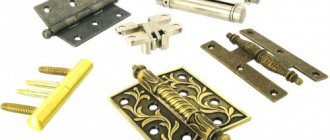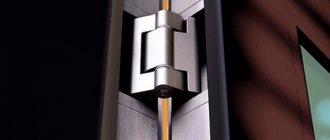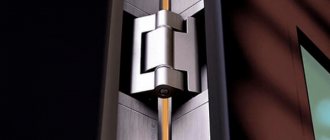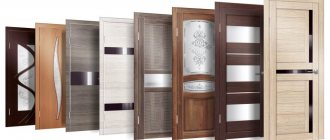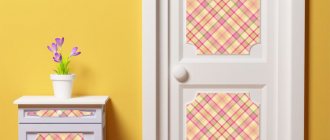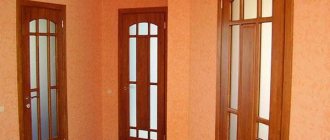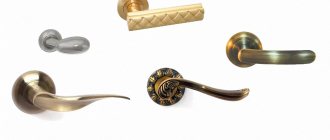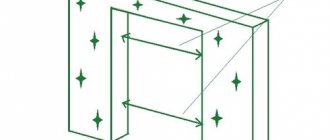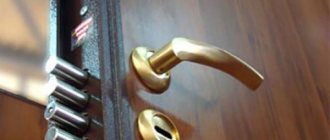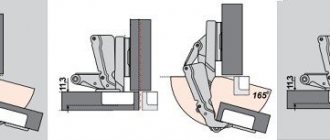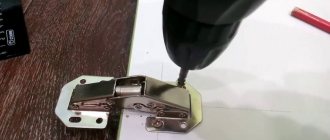High-quality door hinges should fit organically into the design of the room and at the same time have decent performance characteristics. With the current variety of canopies, it can be difficult for a simple home craftsman to make a choice. Let's look at the main types of door hinges together and try to understand for which designs certain models are better suited.
Each door hinge has its own purpose and was developed for a specific type of structure
Rules for choosing door hinges
Canopies for doors that are mounted indoors can be divided into the following groups:
- by installation location - entrance or interior, universal, left and right;
- by type of fastening - overhead, mortise, screw-in, hidden;
- according to the design of the mechanism - one-piece and detachable;
- Material: stainless steel, brass, aluminum, powder alloys.
Entrance doors are the heaviest. They often weigh 80 – 150 kg. They are suitable for mortise or universal hinges with a height of 14–15 cm. Such devices are often produced with a countermeasure mechanism, depriving unexpected “guests” of the opportunity to lift the door leaf and remove it from the hinges. There is a protrusion on one of the wings, and a depression on the other. When the wings are combined, the protrusion fits into the depression, forming a lock.
To install plastic or metal doors, it is better to use the fittings that are supplied with the door block. Usually, door leaves for an apartment or house are bought identical in the same store with handles and hinges identical to each other. The more the sash weighs, the better and more securely it should be secured.
The required number of door canopies for one door, depending on its weight, size and type of hinges according to Russian standards:
| Door leaf weight, kg | 8 × 6 U or L/R | 8 × 6 U2 | 10 × 7 U or L/R | 10 × 7 U4 | 12 × 8 U or L/R | 12 × 8 / U4 |
| 20 | 2 | 2 | — | — | — | — |
| 30 | 2 | 2 | 2 | 2 | — | — |
| 40 | 3 | 2 | 2 | 2 | 2 | — |
| 50 | — | 3 | 3 | 2 | 2 | 2 |
| 60 | — | — | — | 3 | 3 | 2 |
| 70 | — | — | — | — | 3 | 3 |
| 80 | — | — | — | — | — | 3 |
The hinge size is indicated in cm, U2 and U4 are universal one-piece hinges with two or four bearings, L/R are left or right detachable. Hinges 12 × 8 and 10 × 7 are installed on a door leaf 4 cm thick. Both hinges 10 × 7 and 8 × 6 can be installed on doors with a thickness of 3 – 3.7 cm.
The result of using awnings that are unsuitable in terms of technical parameters or functionality can be:
- incomplete closing and distortion of the door;
- inability to move furniture from room to room;
- accelerated wear or breakage of hinges;
- the inability to adjust the position of the doors in the opening or the inability to open them at an angle sufficient, for example, to move furniture;
- splitting of the door leaf.
And if, to ensure the safety and functionality of the door, it is enough to install the simplest steel support fittings that match the technical characteristics of the material and design of the doors, then from the point of view of aesthetics, the hinges should match them in color, match the interior design in shape, material and design.
It is difficult to imagine, for example, classic universal steel canopies in an apartment decorated in Modern or High-Tech styles. What to do if the pens purchased for decorating a nursery are pink? The answer, if you look at it, is simple: you need to install hidden or end mechanisms on the door. They are not visible.
Types of door awnings
Metal and plastic doors are often sold with hinges already installed; a home craftsman can only adjust them; step-by-step instructions for fine-tuning such canopies with photos and videos are “HERE” . And we will try to understand those canopies that you can install with your own hands.
Overhead hinges
Overhead hinges on doors have been made since the times when people learned to forge metal. Forged awnings look luxurious, but they are not suitable for every interior. They are often placed on doors in classic log cabins and wooden houses, and the canvas for such canopies is made exclusively from solid wood.
In addition to high strength, the main advantage of forged canopies is their uniqueness; such products are forged individually and each hinge is unique
In addition to forged models, simpler stamped versions are also produced; their price is low, but they are installed only on utility rooms and wooden gates. The load-bearing capacity of such canopies is quite decent, but the appearance leaves much to be desired.
Stamped models of overhead awnings are not expensive and are mainly used for doors in barns and other utility rooms
Mortise removable canopies
The design consists of 2 plates, on one of which a pin is attached, and on the other there is a kind of tube with a hole in the center. Among the craftsmen, such a mechanism is called “father-mother”. A plate with a pin (male) is attached to the frame, and a plate with a hole (female) is screwed to the end of the door leaf.
According to popular rumor, such loops were developed in the USSR and began to be mass produced after the war. The main advantage of this mechanism is the ease of installation, plus the doors on such canopies can be removed and re-hung in a couple of minutes. They are not suitable for entrance doors - this is an exclusively interior option.
The simplicity of the design of removable mortise canopies determines their high reliability and reasonable price
Advice! When choosing removable hinges for interior doors, it is better to give preference to models that have a bearing between the plates. Their price is a little higher, but their service life reaches 50 years, plus they do not creak.
Card mortise hinges
Card hinges are universal designs; there are no right or left hinges. They consist of two almost identical plates, which are connected to each other by a central rod.
Card awnings for interior doors are somewhat different from models designed for wooden entrance doors. The central rod in the interior version can be removed and inserted back, but on hinges for entrance doors this rod is sealed tightly and if you need to remove the panel, you will have to unscrew the hinges completely.
In canopies for entrance doors, the limiter is soldered to the rod, and in interior models this limiter is unscrewed, as a result the door can be removed
Butterfly loops
Butterflies got their name because the mounting plates are hidden inside each other. Officially, they belong to the family of card canopies, but they differ from other models in that they do not require insertion - these are exclusively overhead hinges.
You can fasten such a canopy with just a screwdriver; there is no need to cut any slots for the mounting plates. The price of butterflies is quite reasonable, but the load-bearing capacity of the most powerful model is limited to 20 kilograms.
Advice! It is not difficult to install butterfly hinges with your own hands, but during installation you need to be very careful to ensure that the central rod of all canopies is on a common center line, otherwise the doors will quickly become loose.
When installing butterfly hinges, remember that the inner (small) plate is attached to the door leaf, and the outer (large) plate is screwed to the frame
Corner hinges
Similar canopies are available for rebated doors. Professionals are not inclined to classify corner hinges as a separate design group, this is due to the fact that in the line of the same butterflies and card canopies there are corner models. They are mounted using the same technology as their direct relatives.
Corner models are present in all types of card and removable canopies
Double-sided loops
In apartments and private houses, such canopies are used extremely rarely; the trick here is that the door leaf can open both inside and outside the room. Such structures are mainly installed on the doors of offices and administrative buildings. When choosing, it is advisable to give preference to double-sided hinges with a closer; these models are capable of returning the door leaf to its original position.
When choosing a double-sided canopy, there is no need to save money, since these structures are subject to heavy loads
Advice! If you do not have the proper experience for installing double-sided canopies, it is better to call a professional, otherwise the doors may constantly deviate in one direction.
Screw-in hinges
Screw-in awnings are a kind of symbiosis of mortise and overhead models. The mechanism is connected according to the male-male principle. One part of the canopy is screwed into the door frame, and the second into the end of the leaf, while the connecting mechanism remains open and visible.
Special door blocks are produced for screw-in hinges, in which the door leaf does not completely fit into the groove of the frame
Screw-in hinges come with one, two or even three pins, on each section of the structure, it all depends on the load-bearing capacity. But the maximum weight of the fabric for such loops should not exceed 40 kg; in this respect, they are similar to butterflies.
Traditional screw-in hinge fastening scheme
Hidden hinges
There are hidden hinges for both entrance and interior doors; there are even furniture models. The main advantage here is invisibility and the possibility of fine adjustment of the design.
It is impossible to cut or somehow get to the secret canopies with the doors closed, except by roughly knocking down the doors. But hidden structures also have a serious disadvantage - this is the price; for one unit you will have to pay from 1,500 rubles. You can learn more about the types, adjustment methods and do-it-yourself installation options “HERE” .
At the moment, hidden canopies for entrance and interior doors are produced; in addition to them, there are a number of models designed for furniture installation
Material selection
Door hinges are made from ordinary black steel, stainless steel and brass, which is an alloy of copper and zinc, sometimes supplemented with aluminum. Brass canopies, unlike steel and stainless steel, are cast rather than stamped. They are not cheap, but they are distinguished by precision workmanship and high quality decorative coating.
The color of the hinges most often imitates any metal: gold, nickel, chrome, copper or bronze. Their surface can be either glossy or matte. Stainless steel canopies are resistant to corrosion. They can even be placed on the entrance doors of a private house. Typically, such rotary mechanisms are not painted.
Differences in hinges based on material of manufacture and coating
It is impossible not to mention the classification of hinge fittings according to the material used in their production. The choice on the market cannot be called rich:
- Steel. Steel is the oldest material for this, which was also used to create medieval forged items. The metal withstands temperature fluctuations, exposure to water and its evaporation. Therefore, steel is ideal for outdoor buildings.
- Alloys of steel with aluminum, zinc, copper. This type is coated in factories with a useful anti-corrosion and decorative coating - chrome, brass, “bronze” and “gold plated”.
- Brass. The metal is valued because it is easily polished and retains its appearance. But in terms of wear resistance, strength and durability, brass is seriously inferior to steel.
Types of door hinges
The design of the canopies that hold the door leaf in the opening determines its functionality and ease of use. At what angle the interior door leaves will open, whether the door leaf will rotate along the central axis of the opening or whether it will consist of two leaves, one of which will be closed for the next 10 years, depends on the preferences of the owner of the house.
The main thing is to know in advance about the possibilities of hinges that can actually be found in the store and make a choice that suits your desires and ideas.
Hinges depending on installation location
The first division is based on the type of alignment for which they were created:
- Input structures. Since such fabrics are more massive, more durable, they require powerful and reliable materials made of durable materials that are resistant to cold, heat, moisture and fumes.
- Room designs. The fittings for doors inside the house are less powerful, but more varied in their internal structure. After all, the main function of a canopy for an interior passage is to ensure the movement of the door and keep it in the jamb.
Invoices
Overhead awnings are universal, fixed with self-tapping screws, and suitable for any door leaf.
They are used if there is no possibility or desire to bury the wings in the door leaf. To prevent hinges from creaking, reinforced models designed for heavy door leaves are equipped with anti-creaking rings made of steel or roller bearings. One of the popular options for such loops is the butterfly. The hinge wings are asymmetrical. The cutout on one of them repeats the shape of the second, due to which they are folded in one plane.
Features of screw-in hinges
Screw-in hinges are a slightly different story. They consist of two symmetrically located parts with holes for mounting screws. Instead of plates, they have cylinders that screw into the door frame and door leaf. They are best suited for doors with a “European sash”. The fashion for these loops came to us from there. Let's evaluate their advantages and disadvantages. Advantages:
12.jpg
Screw-in hinge
- They are practically invisible, the door looks neat.
- They can be adjusted, they allow you to eliminate distortions.
- The cheapest of what the market offers.
13.jpg
Screw-in hinge in door
And here are the disadvantages:
- Since they screw directly into the door, the panel must be thick enough.
- Low load capacity, no more than 30 kilograms.
- Installation is somewhat more complicated; it requires a template.
- Two loops are usually not enough. It is recommended to hang even light doors on three hinges.
- It is impossible to remove the door from the frame without a screwdriver.
Screw-in hinges are not suitable for our standard doors.
Mortise right and left
These canopies consist of two parts, a support part, on which there is a pin, which represents the axis of rotation, and a counter part, which is hung on the pin. The design allows, if necessary, to remove the door without unscrewing the hinges. Depending on which side of the opening, left or right, the door leaf will be attached, the canopies can be left or right.
To choose the right option for the door leaf of an apartment or house, you need to stand facing the opening so that the door opens towards you. If you want the door leaf to be attached to the door on the side of your left hand and to open in this direction, you need to buy left-hand hinges. To hang the door leaf on the right side of the hinge, you will have to buy right-hand hinges
In some countries, awnings are classified into left and right in reverse. In order not to make a mistake in choosing right or left hinges, it is better to draw a plan of the house or apartment on a sheet of paper with the doors open and ask for help from the sales assistant of the store where you are going to buy them.
Detachable and universal hinges
Having decided which door you will need awnings for, take a look at the following grouping - by internal structure.
Detachable hinge
Their peculiarity: to remove the fabric from the hinges, you do not need to unscrew it. Such models are also popularly known as “mom and dad”. The base of the lower loop (finger) fits into a special hole (fist) of the upper one. Therefore, to remove the door, you just need to open it and lift it.
Universal loop
Universal canopies are, accordingly, one-piece. If you have to remove the canvas, you need to start by unscrewing them. There is a big disadvantage to this: it is not always possible to install the fittings correctly in their original place. Screws screwed twice into the same place begin to “sway”, and the canvas itself begins to “walk” when opening and closing. This drawback is half offset by the feature for which such canopies are called universal.
universal loop
End
These same awnings are called Italian or heel awnings. They are mounted at the ends of the door, located closer to the side of the door on which the door leaf is attached, in the lower and upper corners. Doors hung on heel hinges can be opened 180° and, without removing them, their position can be adjusted in three planes. End canopies are universal.
They are suitable for most lightweight door designs without a rebate, the thickness of which varies between 4.1 - 4.5 cm. Hidden heel hinges are also available. They can also be installed on door leaves with a width of one to two meters from the ends in the center of the door, thereby ensuring its rotation by 360 °.
Hidden hinges
15.jpg
Hidden door hinges in the interior
Hidden hinges, they are also called secret hinges, because when the door is closed they are completely invisible. They have at least three rotary axes and their installation is quite complicated. Doors are equipped with such hinges directly at the factory. Finding them in stores is very difficult. They allow you to adjust the door in three planes - horizontally, vertically and by pressing force. To do this, simply tighten the screws without removing the canvas. These are the very doors that are completely suitable for modern styles - high-tech, modern, futurism and so on. Well, now let’s expose this innovation:
16.jpg
Hidden hinges
- They have a small opening angle. You cannot bring large items through such a door.
- They are not visible only when the door is closed. When open, the entire structure faces out.
- Special requirements for the thickness of the canvas. The door should be no thinner than 4 centimeters.
- Complicated and expensive insertion.
- It is very difficult to remove the door from its hinges if repairs are needed.
- The hinges themselves are also very expensive.
Whether it makes sense to install such loops in an apartment is up to you to decide. Moreover, if you are an uncompromising fan of sharply modern styles, then this is the only option.
Which ones are better to choose for interior doors?
To make the doors look good in the interior and be easy to use, before you go shopping, you need to imagine what exactly you want to buy, in what quantity and how much money you plan to spend. Hinges for the front door should not only hold it, but also protect the home from outside penetration.
The quality of heat and sound insulation of the room depends on the tightness of the interior doors. Hinges can be completely invisible against the background of the door leaf or, conversely, decorate the room as a decorative element. Depending on their design features, the door can open 90°, 180° and even 360°, rotating around its axis.
When choosing door canopies, you need to take into account the location of the opening, which way and in which direction the door will open, and the design features of the door leaf. You can install the hinges yourself or call a specialist.
The main thing when installing canopies is to ensure reliability, strength, and load-bearing capacity of fastening the door leaf. If the hinges are not well selected or installed incorrectly, their service life will be significantly reduced. The service life of the door itself will also decrease, which, due to the uneven load received when trying to “force” it to close as it should, will become deformed and lose its appearance.
Versatility of mechanisms
Types of door hinges are divided into two classes: detachable and universal. In appearance, they consist of two plates and a rotating mechanism.
Thanks to their design, detachable types of canopies allow you to remove the door without unscrewing it. The entire system consists of two elements: a pin with a mounting plate and a barrel. These types can be overhead or mortise.
Installation is carried out as follows. The entire hinge is screwed onto the door end, but on the side where the barrel is located. After fitting, a plate with a pin is attached to the box.
Universal types refer to non-removable canopies. This type of hinge is perfect for the front door, as they will not allow you to simply remove it by lifting it.
They are mounted first on the end of the canvas, and then on the box.
But this device also hides the main disadvantage: if you suddenly need to remove the door for a while, this is only possible by unscrewing all the fastening screws.
Conclusion
To summarize, we can note that if your budget is limited and you don’t have a lot of tools, then take butterflies or screw-in hinges. Mortise door hinges are better suited for wooden panels. It is advisable to install hidden canopy models on iron and expensive wooden doors. The video in this article shows the nuances of selection and installation. If the information was useful, then there are social network buttons below, perhaps your like will help one of your friends decide.
The simplest hidden canopy for a heavy metal door.
Mounting methods
Methods of mounting awnings on a door system are determined by their type. Most often, various mortise and overhead types of rotary devices are used, which are secured with self-tapping screws.
Sometimes, on massive doors, overhead hinges with a bolted installation method are used. To do this, the canvas is drilled for fasteners, and the loop itself is tightened with nuts. Bolts and hinges can be hidden overlays made of MDF or metal.
Modern apartments often use durable metal doors. Hinges can be attached to such systems even using a welded connection.
When choosing hinges, they are guided by the specific type of door. For example, the cheapest canvases made from chipboard or MDF make it difficult to use mortise or hidden types of canopies. The same applies to old panel doors, where the entire structure is made on a light frame.
Also, when purchasing hinges, they are guided by the place of their installation; for entrance systems it is better to purchase more expensive canopies with better burglary protection.
And of course, you should proceed from personal capabilities and preferences.
